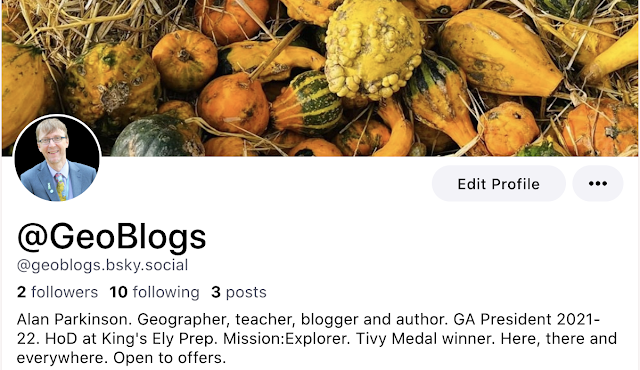I didn't know anything about Fanny Copeland until I came across this article while looking for something on the work of Laurence Dudley Stamp.Special thanks to Richard Clarke for his work on this research.
Born in Ireland, raised in Scotland, she made her life as an adopted Slovene, having lived in a number of European countries.
In this capacity, she welcomed a field trip from members of the Le Play Society, which I have mentioned several times on the blog.
This section talks about Copeland's involvement:
She had invited George Ingle Finch, to lecture.
Finch was also an activist within the London Le Play House Organisation (LPHO).
The LPHO was a key organisation in the development of inter-war British geography.
It had been established in 1920 by a curious mix of geographers, sociologists and educationalists to take forward ‘regional studies’ using an interdisciplinary analytical framework based on the trilogy of ‘place’ (the natural environment, physical and biological), ‘work’ (the economy, and daily life of its people) and ‘folk’ (their community and social organisation).
This approach was itself derived from the work of the 19th century French sociologist Frederick Le Play (who emphasised ‘family’ as the basic unit of society, rather than ‘folk’).
The LPHO provided a home for several bodies, including student groups and a ‘foreign fieldwork committee’ whose emphasis on ‘human ecology’ during the late 1920s became increasingly at variance from that of the Sociological Society (another body within the LPHO which was championing the ‘professional’ disciplinary practice of academic sociology).
The two bodies split in 1931, with the Sociological Society recasting itself as a professional institute - the Institute of Sociology - and the foreign fieldwork committee becoming the nucleus of a separate organisation, the Le Play Society (LPS), under its first President, Patrick Geddes. Geddes died in 1932, shortly after the formation of the LPS and was succeeded as its President by Halford Mackinder.
I'd been unaware of this earlier incarnation of the Le Play Society, or the close link with the IBG. I need to go back to some of my earlier sources perhaps.
The LPS (a precursor of the Institute of British Geographers) became a major influence on the development of geographical fieldwork between the two World Wars. Its first ‘foreign study’ (in August 1932) led by Dudley Stamp was of Solčavsko, a then ‘remote’ Alpine valley system on the Slovene - Austrian border.
It resulted in some outputs:
Dudley Stamp (1933) 'Slovene Studies'This review of the book mentions two other former GA Presidents:
"Halford Mackinder in his Foreword to Slovene Studies described it as ’an honestly made brick for the palace we are rearing.’ (in Stamp 1933) The LPS subsequently held up the 1932 visit as a model of how regional studies should be carried out. The Society's own (1935) guide to regional fieldwork describes it as 'An excellent example of regional survey by a Le Play Society group doing field work as a summer vacation course abroad'. (Barnard 1935: 114, 1948) Thirty years later (after the LPS had been wound up) the visit was described by Beaver (1962: 236) as 'one of the best examples' of the LPS’s work. Beaver did much within the Joint School of Geography at King’s College and LSE during the 1930s to promote fieldwork and his own interest in the Balkans were fostered by his leadership of several LPS ‘expeditions’ (Phillips and Turton 1975)."
At this point the British Association and Section E appear - something else which has appeared quite a few times on the blog.
And this is followed by two more references to former GA Presidents: Sir John Russell (President in 1960) and K C Edwards.
"In 1947, well before the Society’s eventual closure, its ‘student group’ had become a separate body (Turnock 1991), recasting itself as the ’Geographical Field Group’ (GFG) with K C Edwards, by now Head of Nottingham University’s Geography Department as its President. The GFG as a body of ‘professional geographers’ regarded the LPS as elderly amateurs and too ‘sociological’; the emphasis on civics and the Le Play method was dropped (Merchant 2000)"
I now need to find out more about the Geographical Field Group (GFG).
References can be found in the bibliography of the article below.
Copeland lived a long life, full of mountains and connections, and she was described as a "buzzing fly" (hopefully in a positive way).
Clarke says of her:
"In Copeland’s own work one can find elements of the idealism of Patrick Geddes, the mysticism of Vaughan Cornish (especially in her writing on mountains) and the pragmatism of Dudley Stamp."
Hilda Ormsby crops up here too - I love all the connections and interconnections here. There is so much that could be done with this era and the work of GA Presidents...
Source:
Clarke, Richard (2011) "Fanny Copeland and the geographical imagination. Scottish Geographical Journal 127(3) ,pp.163-192
https://eprints.bbk.ac.uk/8156/1/ClarkeAnteric_2011_FannyCopelandGeogImag_SGJ_Pre-Pub.pdf
Stamp, L. Dudley, ed. 1933. Slovene Studies: Being Studies Carried Out by Members of the Le Play Society in the Alpine Valleys of Slovenia (Yugoslavia). London: Le Play Society
Edwards, K.C. 1932. Anglezi studirajo Slovenijo. Planinski vestnik, no. 10: 193-198
Beaver, Stanley H. 1962. The Le Play Society and Fieldwork. Geography 47: 225-240
A quote I got from here as well:
‘Geographical knowledge needs to be understood as something that is constituted through a range of embodied practices (such as travelling, seeing and recording).
The ‘field’ is not some self-evident place, something ‘out there’ to be ‘discovered’ in an unproblematic sense, it is produced in the ideas and the recorded or remembered movements of geographical actors, created through their discourse and shared through the networks of academic (and amateur) exchange.’
(Stoddart and Adams, 2004)
Stoddart, David R and William M Adams. 2004. Fieldwork and Unity in Geography. In Unifying geography: common heritage, shared future, ed. John A Matthews and David T Herbert, London: Routledge.





























